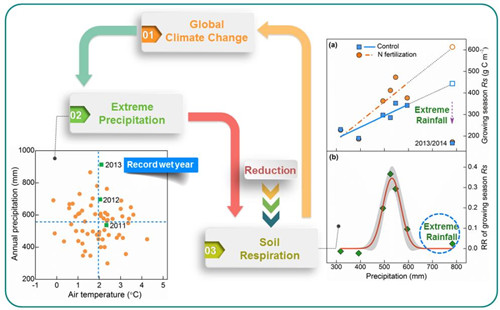It is expected that extreme precipitation events will increase in both frequency and magnitude accompanied by climate warming. The intensified global hydrological cycle can have profound consequences on the terrestrial carbon (C) cycle and its feedbacks to climate change. Soil respiration (Rs) is the largest C flux from terrestrial ecosystems to the atmosphere in the global C cycle with a range of 68–98 Pg C yr-1and exceeds carbon dioxide (CO2) emissions from fossil fuel burning by an order of magnitude. Extreme precipitation is predicted to be more frequent and intense accompanying global warming and may have profound impacts on soil respiration (Rs) and its components, that is, autotrophic (Ra) and heterotrophic (Rh) respiration. However, how natural extreme rainfall or snowfall events affect these fluxes are still lacking, especially under nitrogen (N) fertilization. In this study, extreme rainfall and snowfall events occurred during a 3-year field experiment, allowing us to examine their effects on the response of Rs, Rh, and Ra to N supply. In normal rainfall years of 2011/2012 and 2012/2013, N fertilization significantly stimulated Rs by 23.9% and 10.9%, respectively. This stimulation was mainly due to the increase of Ra because of N-induced increase in plant biomass. In the record wet year of 2013/2014, however Rs was independent on N supply because of the inhibition effect of the extreme rainfall event. Compared with those in other years, Rh and Ra were reduced by 36.8% and 59.1%, respectively, which were likely related to the anoxic stress on soil microbes and decreased photosynthates supply. Although N supply did not affect annual Rh, the response ratio (RR) of Rh flux to N fertilization decreased firstly during growing season, increased in nongrowing season and peaked during spring thaw in each year. Nongrowing season Rs and Rh contributed 5.5–16.4% to their annual fluxes and were higher in 2012/2013 than other years due to the extreme snowfall inducing higher soil moisture during spring thaw. The RR of nongrowing season Rs and Rh decreased in years with extreme snowfall or rainfall compared to those in normal years. Overall, our results highlight the significant effects of extreme precipitation on responses of Rs and its components to N fertilization, which should be incorporated into models to improve the prediction of carbon-climate feedbacks. 
The research achievements have been published in the Global Change Biology. Paper links:(Chen ZM, Xu YH, Zhou XH, Tang JW, Yakov Kuzyakov, Yu HY, Fan JL, Ding WX. Extreme rainfall and snowfall alter responses of soil respiration to nitrogen fertilization: a 3-year field experiment. Global Change Biology, 2017, doi: 10.1111/gcb.13620). http://onlinelibrary.wiley.com/wol1/doi/10.1111/gcb.13620/full (Information source: Nanjing branch of CAS) |

